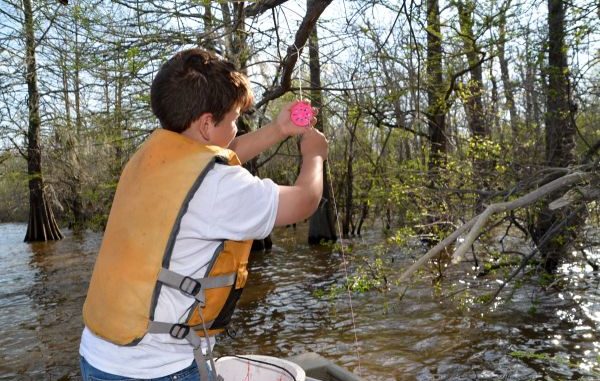
Yo-yos, more properly called automatic fishing reels, are simple but ingenuous devices. Essentially, a yo-yo is a stainless steel spring enclosed within two circular pieces of sheet metal held together by a single rivet in the middle.
One end of a 20-foot length of nylon trotline twine is attached to the spring. The other end of the line has a rather large snap swivel tied to it.
One of the sheet metal discs has a perforated tab on it. Line tied to the tab is used to tie the yo-yo in fishing position to a tree limb over the water.
With a hook on the snap swivel, the yo-yo is ready to fish.
At first glance a yo-yo looks too primitive to catch fish. The heavy line and large, clunky snap swivel are obviously visible to any fish that approaches the baited hook.
But make no mistake about it: Yo-yos are deadly effective pieces of fishing gear, and not just for indiscriminate feeders like catfish.
Yo-yos work very well for finicky crappie (aka white perch or sac-a-lait, depending where you are from), and even largemouth bass fall to them occasionally.
Two brands of yo-yos can be purchased. The White’s Auto Fisher is equipped with a wire, swing-arm trigger. The Mechanical Fisher yo-yo is rigged with either a wire swing-arm trigger or a pivoting flat trigger.
Some anglers prefer flat-trigger models, claiming they are more sensitive. Others consider wire-trigger models more trouble-free.
Regardless of the model, after the hook is baited, line is stripped from the yo-yo to set the hook at the desired depth. The act of stripping out line coils the steel spring tighter and tighter.
When a fish flips the trigger by taking the bait, the spring’s action sets the hook and plays the fish.
The more line the fish takes out, the tighter the spring becomes. As the fish tires or swims back toward the yo-yo, the spring takes up the line and keeps tension on the fish.
Arthur Manuel and Tyler Bordelon tie enough nylon line to make a 14-inch long loop on each yo-yo’s tab. Bordelon drapes the loop over a tree limb and sticks the body of the yo-yo through the loop to attach it to the limb.
Many of their yo-yos are painted hot pink for easier spotting. Unpainted yo-yos are marked with a short piece of colorful surveyors flagging tape tied to a limb near the yo-yo.
Their hook choice will vary, but is often 1/0 gold wire hooks if they expect to catch white perch as well as catfish.
During times of the year when their catch is mostly catfish, they will often use heavier hooks because catfish grow larger and pull harder than do white perch.
Live shiners are their most-commonly used yo-yo bait, followed by worms (Canadian nightcrawlers, locally called “cold worms,”), and for catfish they use blood baits like chicken or rabbit hearts.
In the cooler months of November through February, sac-a-lait is an important target species. In March, catfish numbers begin to pick up, and catfishing steadily improves until the middle of May.
Beginning at the end of April, pest fish activity picks up. Small bream and garfish often knock the baits off yo-yo hooks.
From June through the fall, they seldom fish yo-yos.
After baiting the hook on this trip, Bordelon unspooled enough line from the yo-yo to set the shiner about a foot below the water’s surface.
“That’s a lot deeper than we usually set them,” Manuel said. “I fish deeper when the water is rising. Normally, I set the bait about 4 or 5 inches beneath the surface.”
Bordelon, ever full of information he is quick to volunteer, explained a benefit to the shallow presentation.
“When the shiner is set near the top of the water, it flops on top and the fish hear it,” he said.
The pair set either one or two yo-yos per tree, depending on the availability of branches and spacing.
“I want a branch 2 to 3 feet above the water, and I like to hang the yo-yos away from the trunk of the tree,” Manuel said. “Any higher than that, the spring in the yo-yo will pull them out of the water and they will die.”
Picking trees on which to hang yo-yos on is more than guesswork.
During spawning season in the spring, Manuel feels fish move into shallow water near the banks. As the water rises, as it often does in the spring, he moves his yo-yos farther up on the bank.
Once the water goes over the banks, catfish leave the lake and go in the flooded woods.
The pair likes to have their yo-yos set out about two hours before dark. Prime time is right before dark.

